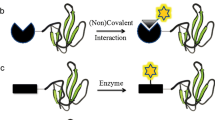Abstract
Appending proteins of interest to fluorescent protein tags such as GFP has revolutionized how proteins are studied in the cellular environment. Over the last few decades many varieties of fluorescent proteins have been generated, each bringing new capability to research. However, taking full advantage of standard fluorescent proteins with advanced and differential features requires significant effort on the part of the researcher. This approach necessitates that many genetic fusions be generated and confirmed to function properly in cells with the same protein of interest. To lessen this burden, a newer category of protein fusion tags termed “self-labeling protein tags” has been developed. This approach utilizes a single protein tag, the function of which can be altered by attaching various chemical moieties (fluorescent labels, affinity handles, etc.). In this way a single genetically encoded protein fusion can easily be given functional diversity and adaptability as supplied by synthetic chemistry. Here we present protein labeling methods using HaloTag technology; comprised of HaloTag protein and the collection of small molecules designed to bind it specifically and provide it with varied functionalities. For imaging purposes these small molecules, termed HaloTag ligands, contain distinct fluorophores. Due to covalent and rapid binding between HaloTag protein and its ligands, labeling is permanent and efficient. Many of these ligands have been optimized for permeability across cellular membranes allowing for live cell labeling and imaging analysis. Nonpermeable ligands have also been developed for specific labeling of surface proteins. Overall, HaloTag is a versatile technology that empowers the end user to label a protein of interest with the choice of different fluorophores while alleviating the need for generation of multiple genetic fusions.
Access this chapter
Tax calculation will be finalised at checkout
Purchases are for personal use only
Similar content being viewed by others
References
Zhang J, Campbell RE, Ting AY et al (2002) Creating new fluorescent probes for cell biology. Nat Rev Mol Cell Biol 3:906–918
Lippincott-Schwartz J, Patterson GH (2003) Development and use of fluorescent protein markers in living cells. Science 300:87–91
Miyawaki A, Sawano A, Kogure T (2003) Lighting up cells: labeling proteins with fluorophores. Nat Cell Biol 5(Suppl):S1–S7
Gautier A, Juillerat A, Heinis C et al (2008) An engineered protein tag for multiprotein labeling in living cells. Chem Biol 15:128–136
Chapman S, Oparka KJ, Roberts AG (2005) New tools for in vivo fluorescence tagging. Curr Opin Plant Biol 8:565–573
Gronemeyer T, Godin G, Johnsson K (2005) Adding value to fusion proteins through covalent labeling. Curr Opin Biotechnol 16:453–458
Griffin BA, Adams SR, Tsien RY (1998) Specific covalent labeling of recombinant protein molecules inside live cells. Science 281:269–272
Keppler A, Gendreizig S, Gronemeyer T et al (2003) A general method for the covalent labeling of fusion proteins with small molecules in vivo. Nat Biotechnol 21:86–89
Los GV, Encell LP, McDougall MG et al (2008) HaloTag: a novel protein labeling technology for cell imaging and protein analysis. ACS Chem Biol 3(6):373–382
Encell LP, Ohana RF, Zimmerman K et al (2012) Development of a dehalogenase-based protein fusion tag capable of rapid, selective and covalent attachment to customizable ligands. Curr Chem Genomics 6(Suppl 1-M7):55–71
Svendsen S, Zimprich C, McDougall MG et al (2008) Spatial separation and bidirectional trafficking of proteins using a multi-functional reporter. BMC Cell Biol 9:17–31
Urh M, Rosenberg M (2012) HaloTag, a platform technology for protein analysis. Curr Chem Genomics 6:72–78
Nath N, Hurst R, Hook B et al (2008) Improving protein array performance: focus on washing and storage conditions. J Proteome Res 10:4475–4482
Hurst R, Hook B, Slater MR et al (2009) Protein–protein interaction studies on protein arrays: effect of detection strategies on signal-to-background ratios. Anal Biochem 392:45–53
Daniels DL, Méndez J, Mosley AL et al (2012) Examining the complexity of human RNA polymerase complexes using HaloTag technology coupled to label free quantitative proteomics. J Proteome Res 11:564–575
Benink HA, McDougall MG, Klaubert DH et al (2009) Direct pH measurements by using subcellular targeting of 5(and 6-) carboxyseminaphthorhodafluor in mammalian cells. Biotechniques 47:769–774
Schroder J, Benink H, Dyba M et al (2009) In vivo labeling method using a genetic construct for nanoscale. Biophys J 96:L1–L3
Hong H, Benink HA, Zhang Y et al (2011) HaloTag: a novel reporter gene for positron emission tomography. Am J Transl Res 3:392–403
Kosaka N, Ogawa M, Choyke PL et al (2009) In vivo stable tumor-specific painting in various colors using dehalogenase-based protein-tag fluorescent ligands. Bioconjug Chem 20:1367–1374
Author information
Authors and Affiliations
Corresponding author
Editor information
Editors and Affiliations
Rights and permissions
Copyright information
© 2015 Springer Science+Business Media New York
About this protocol
Cite this protocol
Benink, H.A., Urh, M. (2015). HaloTag Technology for Specific and Covalent Labeling of Fusion Proteins. In: Gautier, A., Hinner, M. (eds) Site-Specific Protein Labeling. Methods in Molecular Biology, vol 1266. Humana Press, New York, NY. https://doi.org/10.1007/978-1-4939-2272-7_8
Download citation
DOI: https://doi.org/10.1007/978-1-4939-2272-7_8
Published:
Publisher Name: Humana Press, New York, NY
Print ISBN: 978-1-4939-2271-0
Online ISBN: 978-1-4939-2272-7
eBook Packages: Springer Protocols




